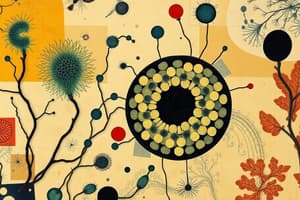Podcast
Questions and Answers
What structure distinguishes eukaryotic flagella from prokaryotic flagella?
What structure distinguishes eukaryotic flagella from prokaryotic flagella?
- 9+2 structure (9 outer & 2 inner) (correct)
- Single strand core
- Base without microtubules
- Flexible tail
Which of the following accurately describes prokaryotic cells?
Which of the following accurately describes prokaryotic cells?
- Reproduces sexually
- Contains a defined nucleus
- Usually contains peptidoglycan in the cell wall (correct)
- Does not have a cell wall
How do prokaryotic cells divide compared to eukaryotic cells?
How do prokaryotic cells divide compared to eukaryotic cells?
- By binary fission with envelope
- By meiosis only
- By mitosis only
- Not by chromosome or nuclear membrane (correct)
Which characteristic is NOT a feature of algae?
Which characteristic is NOT a feature of algae?
What type of algae is abundant in tropical and subtropical areas and plays a critical role in coral reef building?
What type of algae is abundant in tropical and subtropical areas and plays a critical role in coral reef building?
How do the zygotes of algae develop?
How do the zygotes of algae develop?
Which of the following best describes the nitrogen-fixing capability of prokaryotes compared to eukaryotes?
Which of the following best describes the nitrogen-fixing capability of prokaryotes compared to eukaryotes?
What is a significant ecological role of red algae?
What is a significant ecological role of red algae?
What distinguishes prokaryotic reproduction from eukaryotic reproduction?
What distinguishes prokaryotic reproduction from eukaryotic reproduction?
Which feature is characteristic of red algae?
Which feature is characteristic of red algae?
In what way do blue-green algae differ from other eukaryotic organisms?
In what way do blue-green algae differ from other eukaryotic organisms?
What is a primary ecological function of red algae in marine environments?
What is a primary ecological function of red algae in marine environments?
Which of the following best describes the size range of algae?
Which of the following best describes the size range of algae?
Which statement about the cell wall composition is true for prokaryotes?
Which statement about the cell wall composition is true for prokaryotes?
Which of the following statements characterizes eukaryotic flagella?
Which of the following statements characterizes eukaryotic flagella?
What represents a significant difference in the nitrogen-fixing abilities between prokaryotes and eukaryotes?
What represents a significant difference in the nitrogen-fixing abilities between prokaryotes and eukaryotes?
Which feature is NOT typical of algae?
Which feature is NOT typical of algae?
Flashcards
Prokaryotic cell wall
Prokaryotic cell wall
Usually contains peptidoglycan.
Eukaryotic cell wall
Eukaryotic cell wall
Usually does not contain peptidoglycan.
Prokaryotic Reproduction
Prokaryotic Reproduction
Usually no sexual reproduction, but some bacteria can reproduce sexually.
Eukaryotic Flagella Structure
Eukaryotic Flagella Structure
9+2 arrangement (9 outer and 2 inner microtubules).
Signup and view all the flashcards
Algae
Algae
Unicellular or multicellular photosynthetic organisms lacking specialized roots, stems, and vascular bundles.
Signup and view all the flashcards
Rhodophyta
Rhodophyta
Red algae, abundant in warm areas, some involved in coral reef building.
Signup and view all the flashcards
Nitrogen Fixation in Prokaryotes
Nitrogen Fixation in Prokaryotes
Some prokaryotes can fix nitrogen.
Signup and view all the flashcards
Algae Diversity
Algae Diversity
Range from tiny to large multicellular seaweeds.
Signup and view all the flashcards
Prokaryotic Flagella
Prokaryotic Flagella
Flagellum, when present, does not have the characteristic 9+2 structure (9 outer and 2 inner microtubules).
Signup and view all the flashcards
Eukaryotic Flagella
Eukaryotic Flagella
Flagellum has a characteristic 9+2 structure (9 outer and 2 inner microtubules).
Signup and view all the flashcards
Prokaryotic Nuclear Division
Prokaryotic Nuclear Division
Nuclear division is not by chromosome or nuclear membrane.
Signup and view all the flashcards
Eukaryotic Nuclear Division
Eukaryotic Nuclear Division
Nuclear division usually by mitosis or meiosis.
Signup and view all the flashcards
Nitrogen Fixation
Nitrogen Fixation
Some prokaryotes can fix nitrogen.
Signup and view all the flashcards
Algae: Cell Structure
Algae: Cell Structure
Lack specialized root, stem, or vascular bundles.
Signup and view all the flashcards
Algae: Reproduction
Algae: Reproduction
Lack diploid embryo stage, zygote development by mitosis or meiosis.
Signup and view all the flashcards
Rhodophyta: Importance
Rhodophyta: Importance
Critical role in coral reef building (encrusting calcified corallines), consolidation role.
Signup and view all the flashcardsStudy Notes
Prokaryotes vs. Eukaryotes
-
Prokaryotes:
- Cell wall usually contains peptidoglycan.
- Nuclear division not by chromosome or nuclear membrane.
- No sexual reproduction, but this process occurs in some bacteria.
- Flagella, when present, lack a 9+2 structure.
- Some can fix nitrogen (e.g., bacteria and blue-green algae).
-
Eukaryotes:
- Peptidoglycan absent.
- Nuclear division usually by mitosis or meiosis.
- Sexual reproduction is common.
- Flagella have a characteristic 9+2 structure (9 outer + 2 inner).
- Non can fix nitrogen (e.g., all other plants and animals).
Common Characteristics of Algae
- Algae range from tiny single-celled microalgae to giant seaweeds exceeding 50 meters.
- Defined as photosynthetic organisms (unicellular or multicellular).
- Lack specialized root, stem, and vascular bundles.
- Lack a diploid embryo stage.
- Lack sterile tissue surrounding reproductive structures.
- Zygote development occurs via mitosis or meiosis, not via embryo formation.
Rhodophyta (Red Algae)
- Abundant and diverse in warm tropical and subtropical areas.
- Some found in temperate and polar seas, including some unicellular forms in hot springs.
- Critical in coral reef building (encrusting, calcified corallines), contributing to consolidation.
- Carbonate deposits, formed from overlaid red algae and calcium carbonate in cell walls, play a global role in carbon storage.
- Deepest photosynthetic eukaryotes, potentially found over 210 meters deep (Bahamas).
- Some show parasitic tendencies on macroalgae (including other red algae).
- 6,000 species; predominantly marine (97%), with smaller freshwater (3%) and subaerial (<1%) populations.
- Identified by bright pink pigments, phycoerythrin and phycocyanin.
- Phycoerythrin efficient light harvester (blue and green light, subtidal zones).
- Freshwater red algae often exhibits bluish coloration due to higher levels of phycocyanin
- Rhodophyta in high light conditions display a spectrum of colors like yellow, violet, brown, or black from photoprotective carotenoid pigments.
Batrachospermum sp.
- Found in clear, cold, flowing freshwater streams.
- Deep water algal species are dark violet or reddish-brown.
- Shallow water species are olive green.
Thallus of Red Algae
- Thallus of red algae is more delicate compared to brown algae.
- Motile forms are absent.
- Even reproductive cells are non-flagellated.
Thallus Forms (Red Algae)
- Many species exhibit a multicellular, macroscopic thallus in diverse forms.
- Uniaxial: Axis formed by one row of filaments.
- Multiaxial: Axis formed by more than one row of filaments.
Cell Wall Structure
- Two main components
- Cellulose fibers (rigid), a glucose polymer.
- Gels of sugar polymers, or polysaccharides (flexible).
Plastids (Rhodophyta)
- Rhodophyta plastids exhibit two general types of morphologies:
- Axial, Stellate: (e.g., Porphyridium) have large plastids with a central paranoid structure.
- Parietal, Discoidal: (e.g., Audouinella) Characterized by multiple, smaller plastids, often lacking paranoids, with Rubisco located between thylakoids.
Storage Products (Red Algae)
- Floridean starch is the storage product.
- Lack amylose (unbranched portion).
- Contains amylopectin (highly branched portion) in alpha-1,4 linkage polymer.
Pit Connections (& Cytokinesis)
- 90% of cells do not completely divide.
- Open regions are eventually plugged with proteins; little evidence for cytoplasmic communication.
- Ordinal level taxonomic character (core & cap morphology).
- Primary pit connections -Open end eventually plugged with proteins, called a primary pit plug (PPP).
- Secondary pit connections- Cytoplasmic connections can be re-established and eventually plugged with proteins and lend strength to filaments.
Reproduction in Red Algae
- Vegetative: Cell division and fragmentation in some multicellular red algae.
- Asexual: Monospores.
- Many taxa primarily utilize vegetative and/or asexual reproduction.
Studying That Suits You
Use AI to generate personalized quizzes and flashcards to suit your learning preferences.




